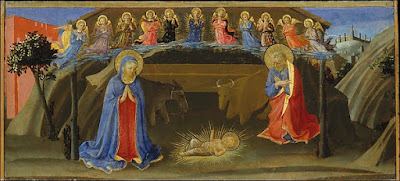Of all the revelations of Christianity, the Incarnation must surely remain one of the least understood. God was somehow present in an innocent child, born in a Bethlehem stable, already destined to be one like us in all our poverty, pain, and failure. And yet in all the “mess” of human life, we encounter this newborn baby, come to us as our long-awaited Savior, lying in an ordinary feed trough.
As the Gospel tells us, “He came but the world did not know him.” We ourselves often do not know or recognize him, but the Incarnation we celebrate urges us to look at things familiar until they become unfamiliar again until we recognize the divine light glimmering deeply within.
The birth of Christ reveals and completes what the document Gaudium et Spes calls “the mystery of our humanity.” Avery Dulles once wrote: “Christmas does not give us a ladder to climb out of the human condition. It gives a drill to burrow into the heart of everything that is, and there, find it already shimmering with divinity.” That is essential to the meaning of “and the Word became flesh, and dwelt among us.” The Christmas surprise is that now “flesh is inspirited and spirit is enfleshed” in a way that changes all of us, indeed all of creation, forever.
This is Good News! The deadly dualism between heaven and earth collapsed that first Christmas morning. Nature and grace are now forever intertwined. They have become inseparable in Jesus. His Birth among us teaches us how to recognize the everyday God who comes to us disguised in the shadow and light of our lives, to keep reminding us of the closeness of a God whose home is always here.
Christmas reveals that there is a light within the darkness, a love within the Cross, a life within each death. Our sins and certainties, our wayward compulsions, our despair and desperation, the wars and poverty we collude in - all are redeemed by the One whose birth we celebrate. The Baby looking up into our faces from the manger is the human face of God, and he reveals to us who we ourselves truly are - flawed but immortal diamonds reflecting the beauty of God. Who would have ever expected that?
This is Good News! The deadly dualism between heaven and earth collapsed that first Christmas morning. Nature and grace are now forever intertwined. They have become inseparable in Jesus. His Birth among us teaches us how to recognize the everyday God who comes to us disguised in the shadow and light of our lives, to keep reminding us of the closeness of a God whose home is always here.
Christmas reveals that there is a light within the darkness, a love within the Cross, a life within each death. Our sins and certainties, our wayward compulsions, our despair and desperation, the wars and poverty we collude in - all are redeemed by the One whose birth we celebrate. The Baby looking up into our faces from the manger is the human face of God, and he reveals to us who we ourselves truly are - flawed but immortal diamonds reflecting the beauty of God. Who would have ever expected that?
The Nativity, attributed to Zanobi Strozzi (Italian, Florence 1412–1468 Florence), ca. 1433–34, tempera and gold on wood, 7 3/8 x 17 1/8 in. The Metropolitan Museum of Art. Used with permission. Excerpts from Father Dominic's homily from Christmas Day.

